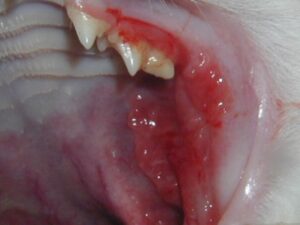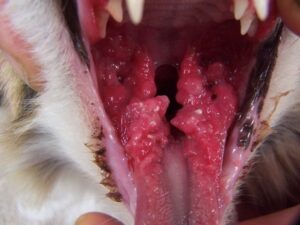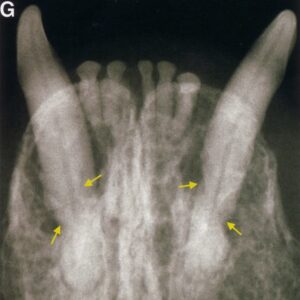
Feline Chronic Gingivostomatitis (FCGS) is a severe inflammatory disease of the oral mucosa in cats. The exact cause of the disease is unknown, as there are multiple factors involved in its development. The inciting factor is likely an abnormal response to plaque bacteria.
Plaque is a biofilm composed of a large number of microorganisms that is very adherent to the teeth. Essentially, any oral infection or inflammation that causes damage to the oral mucosa can be a trigger for stomatitis (viral or bacterial infections, periodontal disease, tooth resorption, environment, stress, diet, etc). The condition is believed to be immune-mediated. That means the body is attacking its own cells. The damaged mucosa releases antigens, and in response to this, antibodies are produced against the host’s own oral mucosa. In a cat with a suppressed immune system, stomatitis will develop.

Inflammation affecting the oral mucosa and the tonsillar area

Severe proliferative inflammation is common in stomatitis
Symptoms
Two of the first signs of stomatitis are bad breath (halitosis) and red gums. The inflammation becomes more severe and extends beyond the gum line into the oral mucosa. The back of the mouth and the tonsillar area can be fiery red with a cobblestone-like appearance. The severe oral inflammation is extremely painful, making swallowing difficult. The affected cats have excessive drooling that can sometimes be bloody, they eat less and lose weight. They can run away from the food bowl, drop food out of their mouth, paw at their face or rub it on the floor.
Animals do not show signs of their pain by crying, but they feel the same pain sensations as humans. Also, they continue eating even when they are sick because the survival instinct is very strong. We can say for certain that stomatitis is one of the very few conditions that will make a cat stop eating because of the tremendous pain and discomfort.
Treatment
There are multiple treatment options described for stomatitis, but we can generally classify them by medical or surgical interventions.
The medical management for stomatitis is aimed at reducing plaque, infection, and inflammation. To reduce plaque, professional periodontal therapy under anesthesia in a veterinary office, followed by brushing teeth daily at home would provide the best results. Admittedly, very few cats enjoy having their teeth brushed, especially those kitties in severe oral pain from stomatitis. Plaque starts developing on the teeth surface in just minutes after brushing or professional cleaning!
Administration of antibiotics and anti-inflammatories by mouth or by injection is a common practice. Unfortunately, the results are only temporary, and the response to medications becomes less effective in time. Medical management ultimately fails due to the inability to effectively fight plaque, which means the immune system of affected cats is constantly attacking the oral mucosal cells.

Teeth affected by periodontal disease and tooth resorption

Tooth resorption in the mandibular canine teeth
The surgical management is currently considered the standard of care for stomatitis. This involves extraction of teeth as the major plaque-retaining surfaces. The extractions must remove the entire tooth, even retained roots of teeth previously lost. The procedure should only be done in a facility equipped with dental X-rays and by a veterinarian with experience in performing extractions in cats.
There are two methods described for surgical management: caudal (all teeth behind the canines) versus full mouth extractions. Caudal extractions are an option only in cases where the front teeth (incisors) and the fangs (canines) are healthy, with no resorptive lesions or periodontal disease. Dental X-rays are mandatory in making that assessment. It is very common to find tooth resorption and periodontal disease in cats affected by stomatitis.
The post-operative pain is managed with systemic injectable drugs in the post-anesthetic recovery period, and oral medications at home. Healing of the extraction sites will take 2-4 weeks, but the comfort level of the patients is dramatically improved shortly after the procedure. It is recommended to feed soft food for the initial 2 weeks after the procedure. Most pet owners will ask “How will my cat eat without teeth?” I can tell you with certainty that cats will have no problems eating once the pain and inflammation are under control! In fact, even cats that prefer dry food will eat their kibble just fine!

Successful treatment 6 weeks post full mouth extractions
The prognosis for full mouth extractions as a treatment for stomatitis is good, but not every cat will be cured. At the first follow-up appointment (usually in 4-6 weeks after the procedure), approximately 40% of the patients will be cured. The additional 60% of patients may need further medical management for a variable amount of time, sometimes for several months. An additional 40% of these cats will do well at the 6-month follow-up and the medication can be discontinued.
Some of these cats (around 20%) will have subclinical stomatitis with residual inflammation, but no clinical signs of discomfort, and they don’t require additional medication. A small number of cats (10%) will need medication for the rest of their life. Some cats do develop refractory stomatitis (7-10%), which means they fail to respond to any treatment, making the prognosis of these cases very poor.
